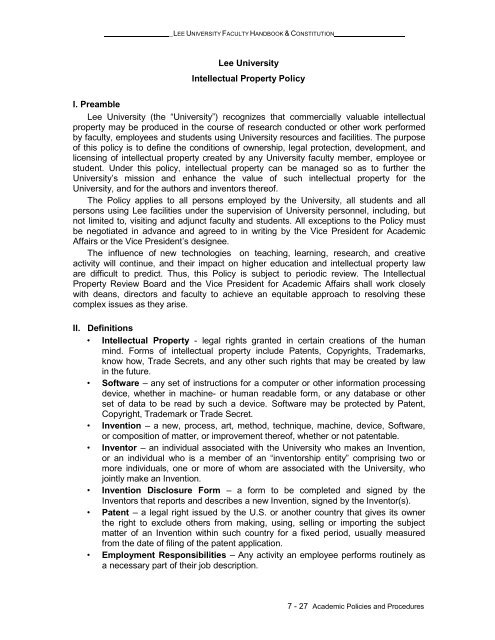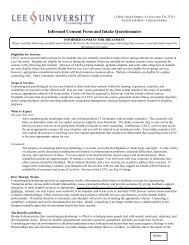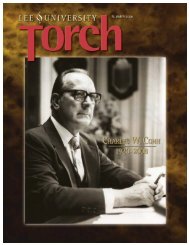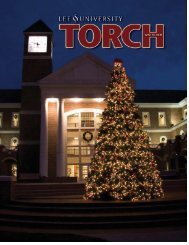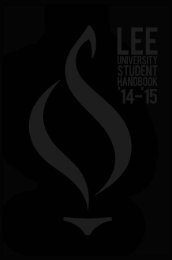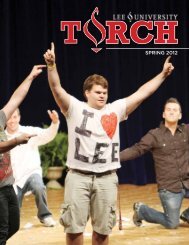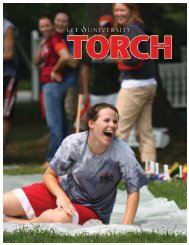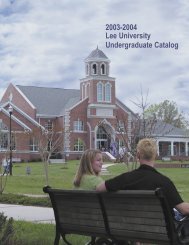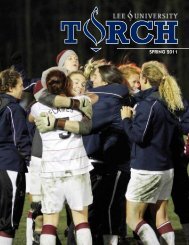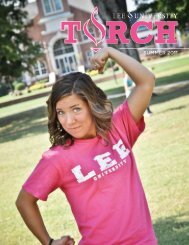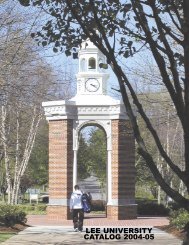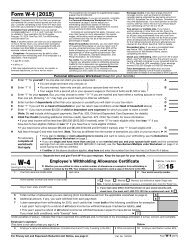Faculty Handbook & Constitution - Lee University
Faculty Handbook & Constitution - Lee University
Faculty Handbook & Constitution - Lee University
- No tags were found...
Create successful ePaper yourself
Turn your PDF publications into a flip-book with our unique Google optimized e-Paper software.
_LEE UNIVERSITY FACULTY HANDBOOK & CONSTITUTION<strong>Lee</strong> <strong>University</strong>Intellectual Property PolicyI. Preamble<strong>Lee</strong> <strong>University</strong> (the “<strong>University</strong>”) recognizes that commercially valuable intellectualproperty may be produced in the course of research conducted or other work performedby faculty, employees and students using <strong>University</strong> resources and facilities. The purposeof this policy is to define the conditions of ownership, legal protection, development, andlicensing of intellectual property created by any <strong>University</strong> faculty member, employee orstudent. Under this policy, intellectual property can be managed so as to further the<strong>University</strong>’s mission and enhance the value of such intellectual property for the<strong>University</strong>, and for the authors and inventors thereof.The Policy applies to all persons employed by the <strong>University</strong>, all students and allpersons using <strong>Lee</strong> facilities under the supervision of <strong>University</strong> personnel, including, butnot limited to, visiting and adjunct faculty and students. All exceptions to the Policy mustbe negotiated in advance and agreed to in writing by the Vice President for AcademicAffairs or the Vice President’s designee.The influence of new technologies on teaching, learning, research, and creativeactivity will continue, and their impact on higher education and intellectual property laware difficult to predict. Thus, this Policy is subject to periodic review. The IntellectualProperty Review Board and the Vice President for Academic Affairs shall work closelywith deans, directors and faculty to achieve an equitable approach to resolving thesecomplex issues as they arise.II. Definitions• Intellectual Property - legal rights granted in certain creations of the humanmind. Forms of intellectual property include Patents, Copyrights, Trademarks,know how, Trade Secrets, and any other such rights that may be created by lawin the future.• Software – any set of instructions for a computer or other information processingdevice, whether in machine- or human readable form, or any database or otherset of data to be read by such a device. Software may be protected by Patent,Copyright, Trademark or Trade Secret.• Invention – a new, process, art, method, technique, machine, device, Software,or composition of matter, or improvement thereof, whether or not patentable.• Inventor – an individual associated with the <strong>University</strong> who makes an Invention,or an individual who is a member of an “inventorship entity” comprising two ormore individuals, one or more of whom are associated with the <strong>University</strong>, whojointly make an Invention.• Invention Disclosure Form – a form to be completed and signed by theInventors that reports and describes a new Invention, signed by the Inventor(s).• Patent – a legal right issued by the U.S. or another country that gives its ownerthe right to exclude others from making, using, selling or importing the subjectmatter of an Invention within such country for a fixed period, usually measuredfrom the date of filing of the patent application.• Employment Responsibilities – Any activity an employee performs routinely asa necessary part of their job description.7 - 27 Academic Policies and Procedures


